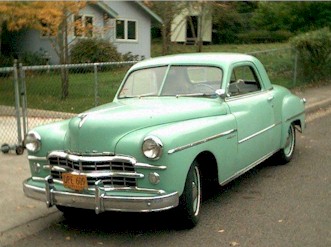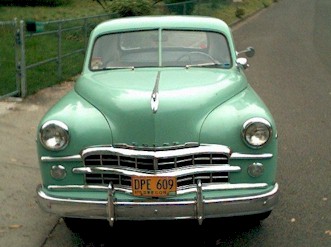|
Carl Best
My coupe was purchased new by my
aunt Bunny in Minneapolis, and driven to California in 1949,
where she had accepted a teaching position at Lincoln High
School in Stockton, California. The Lincoln Union School
District sticker is still in the windshield. I bought the car
from Bunny in 1973, when I was in Stockton doing some work on
her house. I was quite familiar with the car, having been
forced to ride in the space behind the seat along with my
cousins. Fortunately, it's a fairly large space, made even
more ample by the fact that Bunny was only 5' 2" tall, so
the seat was always in it's most forward position. When I got
the car, it needed a lot of mechanical work, having sat
unattended for a number of years. It was otherwise in pretty
good shape, a "rust-free California car" as they say
in Hemmings. I had a replacement engine installed around 1975
at the Sears Automotive department in San Mateo, CA. I recall
that it cost me about $700, or so. The car served me as basic
transportation for quite a few years, and was then placed into
the "hobby/collector" status when I bought a 1964
Falcon Ranchero. I eventually moved here to Eugene, Oregon,
and placed the car into storage, to be brought out once in a
while and driven. Eventually, I lost interest, and just left
it sitting. Amazingly, considering the climate here in Oregon,
the car didn't suffer too much, the motor was still free and
the tires were still inflated (I never jacked the car onto
blocks) after 10 years of sitting, from 1985 to around 1995.
|
 |
Around 1995, I decided to get the car out, and fix it up. The first thing that needed attention was the brakes! I still don't know how I managed to drive it home 8 miles from the barn where it was stored with no brakes, and if you know anything about the emergency brakes Chrysler used in the late 40's, you'd know that mine was no help, even if it hadn't been completely worn out!
|
After rebuilding the brakes, honing the wheel cylinders, and replacing the master cylinder in the process, I pulled the cylinder head off to see why I had 30 pounds of compression on the number 4 cylinder, and 250 pounds on the number 5 cylinder (all the others were about 60, or so). The exhaust valve on number 4 had a neat little pie shaped chunk burned out of it, and the valve lifter on number 5 had about an 8th of an inch clearance at the fully closed position. You could hear both of these problems when you cranked the motor over; uh-uh-uh.......uh, I once heard a car talk "stump the chump" contest where they asked the audience how the old time mechanic knew that a motor needed a valve job after only hearing the starter motor run; I know!-I know!, call on me, I know! You could really hear that pause when the number 5 piston came on compression.
I got to talking to Jerry Collins about my car, and realized that if I was going to pay out $120 a month just to store it, I'd be a lot better off letting it sit in Jerry's shop, and pay him to work on it. He agreed to take on the project, and our needs matched perfectly, he couldn't afford to devote too many hours a week to the car, and I couldn't afford to pay for too many hours a week. First, I hauled the motor over, and he began cleaning it up, and painting it. Eventually, I towed the rest of the car over, and he cleared out a space in his shop for it
|
|
While working on the motor, Jerry found that the main and rod bearings were close to worn out. The crankshaft was still in good shape, so we got some bearings from Doug Crawford of Elderly Auto, a local specialist in antique Chrysler products, and Jerry installed them. I had already taken the bell housing, and some other hardware to the Aircraft Mechanics Dept. at the local technical college where I work, and bead blasted and painted them green, so I got some more of the same green paint and gave it to Jerry to do the rest of the motor. He did a fine job of cleaning everything and making it look nice.
|

|
|
Sometime after he got done with the motor, he showed me a very nifty looking aluminum intake manifold with two Carter carburetors on it, and asked me if I'd like to have that installed in place of the standard intake manifold and carburetor with its oil bath air cleaner. Without thinking, I said, sure! put it in! Then he showed me a pair of old cast iron exhaust headers with three inlets on each one. "you'll have to use these too, if you change your intake manifold", they were the most ugly, rusty, worn out looking things I'd seen in a long time. The bolts holding the exhaust pipe flanges to them were all broken off, and rusted into the threads so badly that they looked impossible, one of the flanges was broken off. Jerry assured me that he knew how to deal with them, and since I'd seen pictures of some of the junk that Jerry had turned into cars in the past, I agreed to let him use them on the car.
Eventually, Jerry restored the headers to their original state, put it all on the motor, and began hooking things up. I was about ready to take the front clip to his shop, when Jerry got the motor running with the battery and radiator propped into place. What a great sound! A few weeks later, the car was ready to take home. I haven't added up all the bills, but I think I probably paid Jerry a total of around $2500 for all the work and parts that he put into it. I had to do quite a bit of tinkering on my own after I got it home.
|

|
As I pointed out in my initial description of the plan for the car, I wasn't expecting to end up with a "restoration", or even something that looked like one. However, I began to realize that this was really a pretty clean car (those gauges looked like a million bucks after a good cleaning!), and that it might be possible to make this thing pretty presentable without doing a major job on it.
|
|
The paint is chipped badly in a few places, but it's a good thick coat of enamel that had been applied in around 1960, probably when Bunny had the motor rebuilt. It takes a shine pretty well, and I went out and bought a fresh can of rubbing compound. I have been working on small areas a little at a time. If you look closely at my pictures, you can see where I've worked on it, and where it's still needing to be done. Interestingly, the front fenders and hood are actually still pretty shiny, since they were stored indoors while the rest of the body sat out in a carport for 5 years. I'll need to completely replace the interior, and there is some rust in the floor, probably no where near as bad as if the car had been in Oregon for 50 years, and not bad enough to require cutting out and replacing, but it will need some work. Doug Crawford recently got in some very good parts from a car that had been parted out for some reason, and I'll be buying the seat from it, which has useable original upholstery (don't bother calling him, guys, by the time this is posted, I'll have the seat in my possession, so a large part of the interior is already in hand. I'm going to try to make my own door panels, and probably the other interior hard panels. I think I can buy a replacement headliner, and I can get new weather-strips, door welts, and window channels from Andy Birnbaum back east.
Oh, and Anne's declaration about the car not coming back? Once she saw how great it looked, and how much our kids liked it, permission was granted to let it stay. After all, how could anyone hate a car like that?
|
|